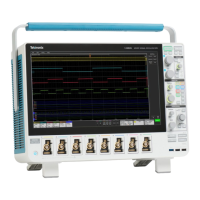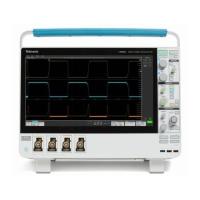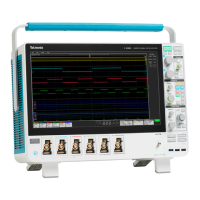PJ
Periodic Jitter (PJ) is the peak-to-peak amplitude for that portion of the deterministic jitter which is periodic, but for which the
period is not correlated with any data pattern in the waveform. A single PJ value is determined for each acquisition, by means of
RJ-DJ separation analysis.
RJ
Random Jitter (RJ) is the rms magnitude of all timing errors not exhibiting deterministic behavior. A single RJ value is determined
for each acquisition, by means of RJ-DJ separation analysis.
RJ 66 measurement algorithm
RJDIRAC (dual-dirac random jitter) is random jitter based on a simplifying assumption that the histogram of all deterministic jitter
can be modeled as a pair of equal-magnitude Dirac functions. This measurement is made across the entire record.
SRJ
Sub-Rate Jitter is periodic jitter at a rate that integrally divides the data rate. For example, if the data rate is F bits/second, sub-
rate jitter components could occur at F/2 or F/4. It typically occurs when a serial data stream is formed by multiplexing
(interleaving) an integral number of lower-rate bit streams together, although there can be other causes. Sub-rate jitter is a sub-
component of PJ.
The SRJ measurement is the peak-to-peak amplitude for the sum of all F/N jitter components that are tracked by DPOJET. Since
different F/N components are correlated with each other, the peak-to-peak SRJ depends on relative phases and is not simply the
sum of the individual F/N components.
The SRJ measurement always tracks and accounts for N = 2, 4 and 8 regardless of whether the corresponding F/N
measurements have been selected.
TJ@BER
Total Jitter at a specified Bit Error Rate (BER). This extrapolated value predicts a peak-to-peak jitter that will only be exceeded
with a probability equal to the BER. It is generally not equal to the total jitter actually observed in any given acquisition. A single
TJ@BER value is determined for each acquisition, by means of RJ-DJ separation analysis.
Eye measurement algorithms
Eye Height measurement algorithm
Eye Height is the minimum vertical eye opening at the mid of the unit interval. This measurement is made across the entire
record.
Eye high
Eye High calculates the voltage at a selected horizontal position across the unit interval, for all High bits in the waveform. You
specify the offset at which the measurement takes place from 0% to 100% of the unit interval. Configure the measurement to
include all bits, only transition bits, or only non-transition bits. (Note that some of the waveform can be omitted from the
measurement due to initialization of clock recovery or filtering.) A histogram of the Eye High measurement corresponds to a
vertical slice through the upper half of a three-dimensional eye diagram.
Measurement algorithms
458 MSO54, MSO56, MSO58, MSO58LP, MSO64 Help

